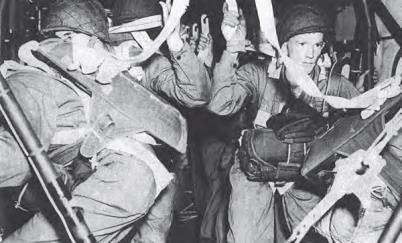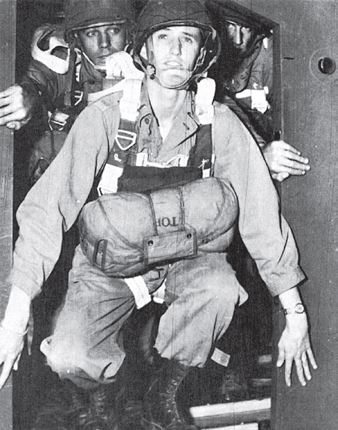National WWII Glider Pilots AssociationLegacy Organization of veterans National WWII Glider Pilots Association. Discover our History, Preserve our Legacy | ||
This portion of the Pathé film, Pathé film, Gliders (1944), is a US Army Signal Corps film from the U. S. National Archives showing the 82nd Airborne drops simutaniously from C-47 and gliders.
Pathé film, Gliders (1944): 1
The complete Pathé film is a combination, but not necessarily in chronological order, incorporating film shots of tactical and demonstration exercises in the Pope, Camp MacKall, Laurinburg-Maxton (L-M), Lumberton area of North Carolina. The Airborne frequented Laurinburg Maxton for training exercises during the summer and fall of 1943 and on October 7th, nine paratroopers were assigned to the 436th Troop Carrier Group (TCG). (They are attached to train crew members the art of jumping in case of emergency. Our glider pilots will, no doubt, aqcuire some training and experience just from carring them along, etc. -81st Historical report USAFHRA)
On October 29th, 1943, the 436th TCG would be tasked with a mission from the 82nd Airborne. A C-47 and two gliders would be loaded with a small number of 82nd Airborne Division troopers. The C-47 would tow the two gliders (dual tow) and after a short time in the air, the C-47 pilot and two glider pilots, simultaneously, would give a jump signal to the jumpmaster and the paratroopers would jump from all three planes at the same time in the vicinity of the air field. The following was mentioned in the 436th Troop Carrier Group, 81st TC Squadron's Historical diary:
October 29
MAJOR BRACK WAS AT THE HELM OF A LOADED C-47 TODAY THAT TOWED TWO GLIDERS LOADED WITH PARATROOPERS. AFTER CIRCILING THE FIELD [L-M] SEVERAL TIMES, THE PARATROOPERS WERE ORDERED TO JUMP FROM THE GLIDERS. FROM ALL REPORTS, THE MISSION WAS MOST-SUCCESSFUL.
The paratroop drops are mentioned in the book, "The Left Corner of My Heart: The Saga of the 551st Parachute Infantry Battalion", by Dan Morgan. According to Morgan the glider jumping was done at Camp MacKall in fall of 1943 and in (early) October 1943 at Alachua, FL for a group of high level officers. It does not specify the exact number of jump flights made but there were not many and the jump in Florida was an exhibition for high ranking officers.2
The Airborne involved were the 551 Parachute Infantry Battalion from Camp MacKall and from Alachua, Florida. Previous research indicates two of the CG-4A pilots were Julian Hall and Gale Ammerman. Both were stationed at Laurinburg Maxton at the time. In Gale Ammerman's book, "An American glider Pilot's Story", Gale reveals that he was one of the pilots of one of the gliders towed by Major Brack on October 29th.3 He noted this was a dual tow.
. . .in an interesting experiment. The C-47 towed two gliders with all three aircraft loaded with paratroopers. The goal of the test was to determine how close together on the ground the paratroopers would be with the technique. Normally paratroopers were dropped from C-47s, and one of the problems which plagued them was how widely they became scattered as they landed. Using the C-47 and two gliders would result in almost thirty additional troopers landing in essentially the same area on the ground.
Paratroopers piled into the C-47 and the gliders. The double-tow take off was routine with the only problem as, usual, being the propeller wash from the planes taking off ahead plus that from the tow plane the glider was attached. In the air cruising along at 500 feet and 120 mph I relaxed. I was looking forward to this new experience. I trimmed the glider carefully so I could fly with minimum of effort. The landing is the crucial event of a glider mission, and I always tried to conserve energy with the landing in mind.
The signal to jump was to be a green light flashed from the observation dome in the C-47 to the glider. As the tow plane approached the drop zone word was passed for the troopers to stand up and jook up bto the temporary static line rigged up the length of the CG-4A, one on each side. Standing ready now the paratroopers were all business. They were the first to ever jump from a combat glider, and when you’re first you never know what to expect.
The airborne jump master saw the green light flash on and he yelled, "Go! Go! Go!"
With shouts and shoves the paratroopers jumped out the doors while inside the glider cockpit things got a little exciting. When the first man exited the glider, I felt the nose of the glider come up. Each time a paratrooper leaped out the load was lightened by about 200 pounds.
I grabbed the trim tab control and cranked wildly as both my copilot and I held forward pressure on the control column. In spite of our best effort the nose of the glider was well above normal and the glider way above normal position in relation to the tow plane. Pressure on the control lessened now as I spun the trim tab control. I flew the glider back into position about the same time as the other glider on the double tow came back down into normal position.
"That was a little hectic for a while." I said.
"Hectic, my ass,” My co-pilot said. “That’s what I call shit for the birds."
The remainder of the flight and the landing was no problem. Word came down to the flight line that the paratroopers had suffered only the usual cuts, bruises, and sprained ankles. My friends and I compared notes and all agreed that we would start the trim procedure before the paratroopers jumped if we ever repeated that mission.
They did not have long to wait; the glider drops were repeated again on Sunday, October 31st. On Saturday the 30th, the entire flying personnel of the 436th Troop Carrier Group were busy planning an air show for Sunday. The plans were for glider-tows and paratrooper drops.
SUNDAY October 31
THE AIR-SHOW CONTINUED ALL DAY - AND THE 81ST AND 82ND SQUADRONS CONTRIBUTED THEIR SHARE TOWARD THE PROGRAM BY TRANSPORTING AND DROPPING 450 PARATROOPERS MOST SUCCESSFULLY FROM 12 PLANES TOWING TWO GLIDERS EACH. THIS IS BELEIVED TO BE THE FIRST TIME THAT LOADED C-47'S HAVE TOWED TWO LOADED GLIDERS EACH, IN FORMATION, ON THIS BASE, - DROPPING PARATROOPERS FROM BOTH THE PLANES AND THE GLIDERS.
The date of October 31st was also verified in the, 82nd Troop Carrier Squadron - History, October 1943.
On the last day of the month a new and different mission took place. The group dropped Paratropers from gliders in double tow, and from tow planes.
These jumps were not considered successful for several reasons. The troopers with their equipment were too large for the CG-4A exit doors which caused problems in their getting into jump position in the door and getting through the door opening. To limit glider flight instability, the troops had to exit from both sides at exactly the same time. The glider was not intended to handle jumpers and was not built or designed with an anchor line. An anchor line was rigged in the gliders but they were not substantial enough and some were pulled loose when the jumpers exited the glider.
One C-47 double towed two CG-4A jumping 42 (total); one jumper reports 11, another implies 13, from each glider and the balance from the C-47. The C-47 started jumping first, one exit door only, the parachutes show in single line behind the C-47. The glider jumpers go out both sides of the glider -- they quickly learned the gliders had to use both doors at same time because of the glider movement when the weight changed as the jumpers exited – the glider chutes show in side by side pairs in photos.


Two main problems were:
- The small size of the CG-4A doors relative to the size of the jumpers especially with some of their combat equipment.
- The steel cable line to which the parachute static lines were hooked were a temporary thing somehow bolted/clamped to the steel tubing in the top of the glider. These cables were not 100% secure. One big jumper, who happened to be last one out, pulled the line out of the glider. Luckily the static line hook was stopped by whatever on the lose end of the steel cable and his chute was opened.
Jumping from the CG-4A was just not practical.
It is also possible that Julian Hall flew one of the gliders on the 29th or 31st. Julian Hall was MOS 1026, graduating from Victorville on Apr 6, 1943. At Laurinburg Maxton he was an instructor and "test" pilot. He did a lot of stuff flying gliders with, and for, Mike Murphy and Chet Decker including piloting the first Horsa snatched at L-M. His son, several years ago, indicated his father was involved with para-jumpers from gliders. However, Julian's flight log does not specify CG-4A jumpers. His log does show that he piloted a YCG-13A on 4 January 1944 in the Camp MacKall area and 30 paratroopers jumped from the glider... I Have never seen a photo of the YCG-13A jump, but there has to be some around. That would be the rare photo to find – similar as was the replacement Fighting Falcon with the "screaming chicken" on the side.
(2:18) Pathé film, Gliders (1944):
=======================
ENDNOTES:
1 In the Pathé film, the Jeep that takes away the anti-tank gun shows 13th A/B Division, 326th Glider Infantry Regiment which did not deploy to Europe until 1945. The empty CG-13A snatch likely involved Julian Hall as glider pilot and C-47 pilot, Chet Decker, on TDY from CCAAF glider test and experiment field. The three side by side CG-4A snatches are astounding and dangerous and required a lot of guts on the part of the tug pilots and the glider pilots!
2 An interviewee who was one of the jumpers recalled that all the pilots for the Florida jumps were Colonels. This to me does not seem possible. As a side note, the Ldb shows nine colonels and does not specify date of that rank as being before 1944. Of the nine, Gable, Price, Shoop, Alison and Rawl could be eliminated as they were assigned elsewhere or are known to achieve rank after 1943. To accept that the pilots were Colonels would require specific research or indicates the pilots were not necessarily MOS 1026 glider pilots).
3 In Ammermann's book he has November, 1943, for the timeframe for the jumps but three 1943 citations from the squadron diaries indicate this occurred in October on the 29 and 31st, 1943.
4 Photo and quote is taken from the article by Troy J. Sacquety, "We badly needed something to do." Vol 3 No 2 pg 31.
5 Ibid, pg31
SOURCES:
AMMERMAN, Gale. An American glider pilot's story. Merriam Press - 2005
MORGAN, DAN. LEFT CORNER OF MY HEART: the Saga of the 551st Parachute Infantry Battalion. Place of publication not identified: Alder Enterprises Publishing, 1st Edition 1984.
U.S. Air Force Historical Research Agency SQUADRON TROOP CARRIER: Historical Report. (A0991 unclassified), Sq TR CARR 81 HI. 1943 .
Ibid, Sq TR CARR 82 HI. 1943.
Sacquety, Troy J. We Badly Needed Something to Do; Glider Jumping At Cap Mackall, 1943. https://arsof-history.org/articles/pdf/v3n2_badly_needed.pdf.
TACTICAL GLIDER TRAINING
COMBAT INFANTRY TRAINING
17th AIRBORNE at
OGBOURNE ST. GEORGE
GLIDER PARATROOP JUMP
FEASABILITY TESTING
ACCOUNTS (Stories/Accidents)
TRAINING SCHOOLS

Drawn by Dale Oliver for the National WWII Glider pilots Association Newsletter, Silent Wings.







